Class 11 Biology Chapter 7 Structural Organisation in Animals, AHSEC Class 11 Biology Question Answer, HS 1st year Biology notes to each chapter are provided in the list so that you can easily browse throughout different chapters Assam Board Class 11 Biology Chapter 7 Structural Organisation in Animals Question Answer and select needs one.
Class 11 Biology Chapter 7 Structural Organisation in Animals
Also, you can read the SCERT book online in these sections Solutions by Expert Teachers as per SCERT (CBSE) Book guidelines. These solutions are part of SCERT All Subject Solutions. Here we have given Assam Board Class 11 Biology Chapter 7 Structural Organisation in Animals Solutions for All Subjects, You can practice these here.
Structural Organisation in Animals
Chapter – 7
VERY SHORT ANSWER TYPE QUESTIONS
Q.1. What is tissue ?
Ans :- A group of similar cells performing similar function are termed as tissue.
Q.2. Based on function how are tissue classified ?
Ans :- Based on functions tissue are classified into 4 types ie.
Epithelial, connective, Muscular and Neural tissue.
Q.3. What is the difference between simple and complex epithelium?
Ans :- Simple epithelium is composed of 1 layer of cells whereas complex epithelium is composed of more than 1 layer of cells.
Q.4. Write the function of ciliated epithelium?
Ans :- It helps to move particles or mucus in a specific direction.
Q.5. What are glandular epithelium?
Ans :- Some of the columnar as cuboidal cells get specialised for secretion and are called glandular epithelium.
Q.6. Name the different types of junction found in the epithelium and other tissue?
Ans :- Tight junction, Adhering junction and gap junctions.
Q.7. Name the excretory organ of cockroach.
Ans :- Malpighian tubules.
Q.8. How many pairs of spiracles are present in cockroach ?
Ans :- 10 pairs.
Q.9. What are Ootheca?
Ans :- The fertilised egg of cockroach are enclosed in capsules called Ootheca.
Q.10. Name the sense organ present in frog ?
Ans :- Organ of touch, taste, smell, vision and hearing.
Q.11. How many vasa efferent arise from tests of frog.
Ans :- 10-12 nos.
Q.12. What is cloaca?
Ans :- The cloaca is a small median chamber that is used to pass fecal matter, urine and sperms to the exterior.
Q.13. How many segments are there in the abdomen of cockroach.
Ans :- 10 segments.
Q.14. Name the parts from where the
a. 1st pair of wings and
b. 2nd pair of wings arises in cockroach.
Ans :- a) Mesothorax
b) Metathorax.
Q.15. Mention 1 difference between male and female of cockroach.
Ans :- Male cockroach bear a pair of short thread like anal styles which are absent in female.
Q.16. How many pairs of spiracles are present in cockroach ?
Ans :- 10 pairs.
Q.17. Write the function of typhlosole ?
Ans :- It increases the effective area of absorption in the intestine.
Q.18. Where are blood glands present in earthworm?
Ans :- In 4th, 5th and 6th segments.
Q.19. How respiration occur in earth worm.
Ans :- Through moist skin.
Q.20. Name the common Indian earthworms.
Ans :- Pheretima and Lumbricus.
Q.21. What is clitellum?
Ans :- In a mature worm, 14-16 segment are covered by a prominent dark band of glandular tissue called clitellum.
Q.22. How many pairs of spermathecal apertures are present in earthworm ?
Ans :- 4 pairs.
Q.23. Where are spermathecal aperture located?
Ans :- 5th to qth segment.
Q.24. Blood gland produced what ?
Ans :- Blood cells and hemoglobin.
Q.25. Name the common species of frog found in India ?
Ans :- Rana tigruna.
Q.26. What is the function of Nictating membrane in frog ?
Ans :- It protects them while in water.
Q.27. How do frog respire?
Ans :- Frog respire either through skin or through lungs.
Q.28. Name the larva of frog.
Ans :- Tadpole.
Q.29. What is aestivation ?
Ans :- During peak summer frog take shelter in deep burrows to protect them from extreme heat. This is called summer sleep or aestivation.
Q.30. What is the function of bile ?
Ans :- It helps in emulsifies of fat particles.
Q.31. How male frog can be distinguish from female frog ?
Ans :- Male frog possess a sound producing vocal sacs and also a copulatory pad on the 1st digit of the forelimbs which are absent in female frog.
Q.32. What is the difference between cutaneous and pulmonary respiration ?
Ans :- In water, frog respire through skin such type of respirations is called cutaneous respiration.
Q.33. Why frog is also termed as ureotelic animals ? Name the organ through which it is create ?
Ans :- The frog excrete urea and so they are also termed as ureotelic animals. The organ is kidney.
Q.34. Write about the female reproductive organ of frog ?
Ans :- It consist of a pair of ovaries near the kidneys. A pair of oviducts arises from the ovaries opens into the cloaca separately.
Q.35. Write about the male reproductive organs in frog ?
Ans :- Male reproductive organs consist of a pair of yellowish ovoid testes. About 10-12 vasa ferenc arises from the testes. They enter the kidney on one side and opens into the Bidders canal on the other side and finally open into the cloaca.
Q.36. Draw the male reproductive organs (in frog) ?
Ans :-
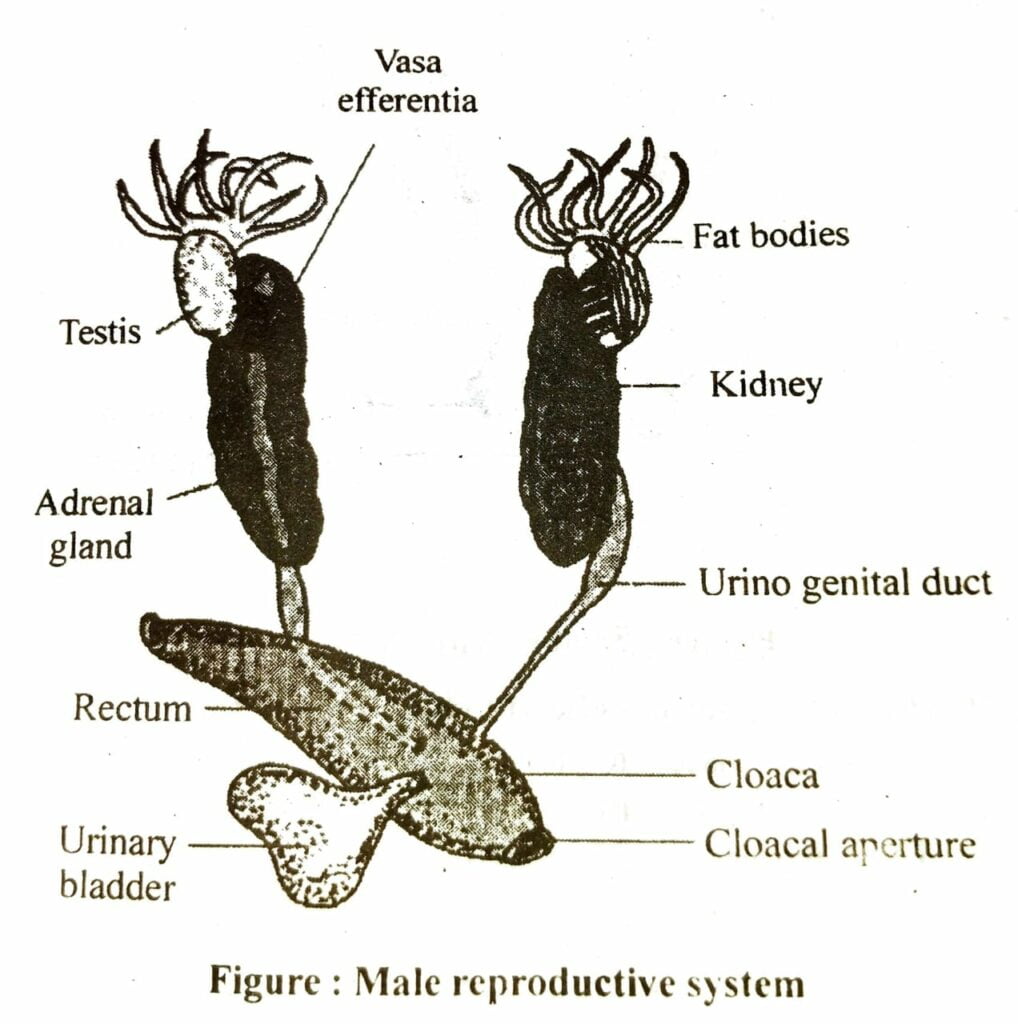
Q.37. Draw the female reproductive organs (in fig)?
Ans :-
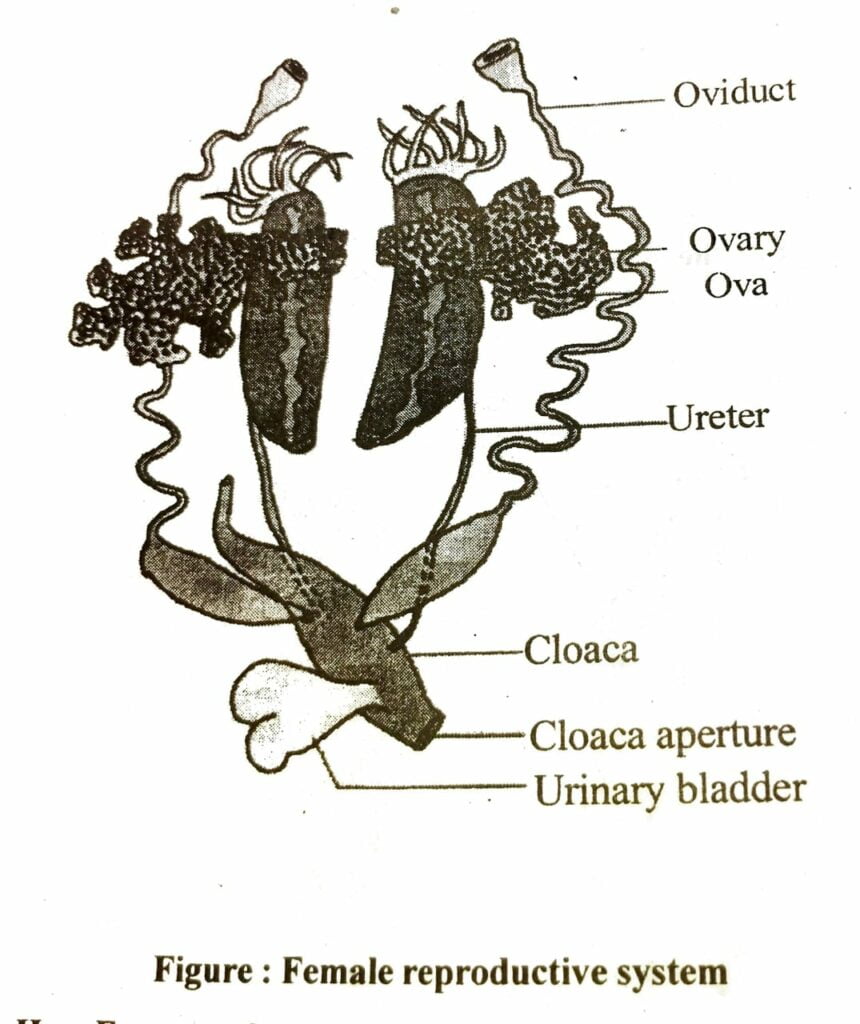
Q.38. How Frogs are beneficial to human being ?
Ans :- a) Frog eats insects to protect the crop.
b) They serve as a link of food chain and food web in the ecosystem.
c) In some countries leg of frog are used as food.
In this way frogs are beneficial to human.
Q.39. Draw the alimentary and of cockroach.
Ans :-
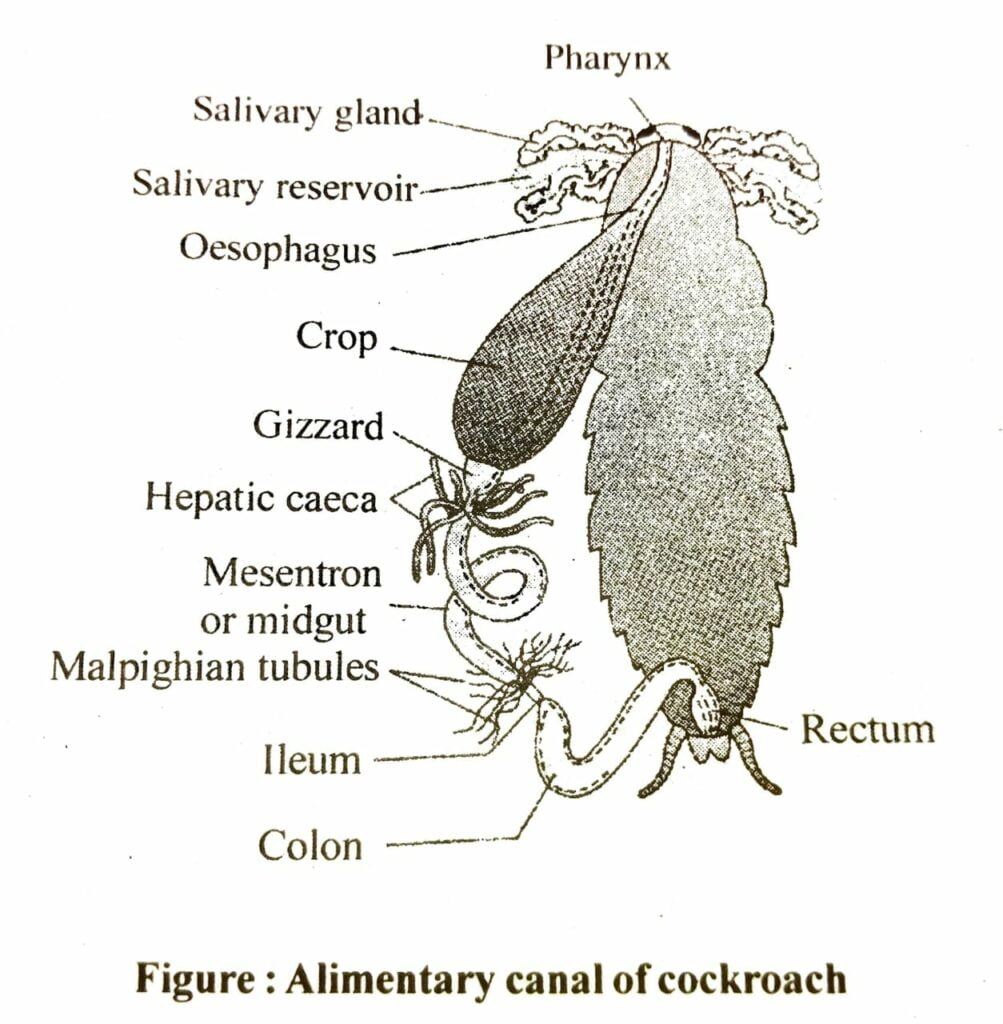
Q.40. Write about the blood vascular system? (in cockroach)
Ans :- Blood vascular system of cockroach is of open type. Visceral organs located in the haemocoel are bathed in blood (haemolymph). Haemolymph is composed of plasma and haemocytes. Heart (elongated muscular tube) lie along the mid dorsal line of thorax and abdomen it is differentiated into funnel shaped chambers with ostia on either ride. Blood from sinuses enter heart through ostia and is pumped anteriorly to sinuses again.
Q.41. Why earthworks are known as friends of farmers ?
Ans :- Earthworks are known as friends of farmers because they make burrows in the soil and make it porous which help in respiration and penetration of the developing plant roots. They are also used as bait in game fishing.
Q.42. Earth worm doesn’t have eyes but still they are sensitive to certain response ? How ?
Ans :- Earthworm doesn’t have eyes but does possess light and touch sensitive organs to distinguish the light intensities and to feel the vibrations in the ground. They also have specialised chemore ceptors which react to chemical stimuli.
Q.43. Name the cells present in Neural system ? Also write their function.
Ans :- Cell present in Neural system are Neurons and Neuroglia.
Neuron helps in transfer the message either from sense organ to brain in a spinal cord or from brain to sense argan. Neuroglial cell give support and protect the neuron.
Q.44. What is the difference between cartilage and Bone.
Ans :-
| Bone | Cartilage |
| 1. It is a solid, rigid connective tissue. | 1. It is solid, cartilage connective tissue. |
| 2. Cells are known as osteocytes occurs singly in a lacunae. | 2. Cells are known as chondrocytes and occurs in clusters of 2or 3 in each lacunae. |
Q.45. What is blood ?
Ans :- Blood is a fluid connection tissue contains plasma, RBC, WBC and platelets.
Q.46. Write the function of bones ?
Ans :- i. It provides structural frame to the body.
ii. It support and protect softer tissues and organs.
iii. The bone marrow in some bones is the site of production of blood cells.
Q.47. What is the difference between tendon and ligament.
Ans :-
| Tendon | Ligament |
| 1. Joins muscles to bones. | 1. Joins bone to bone. |
Q.48. Distinguish between Prostomium and peristomium.
Ans :- Prostomium, is a lobe which serves as a covering for the mouth and as a wedge to force open cracks in the soil where as peristomium is the 1st body segment of earth worm which contains the mouth.
SHORT ANSWER TYPE QUESTIONS
Q.49. With the help of diagram show the different types of Muscular tissue.
Ans :-
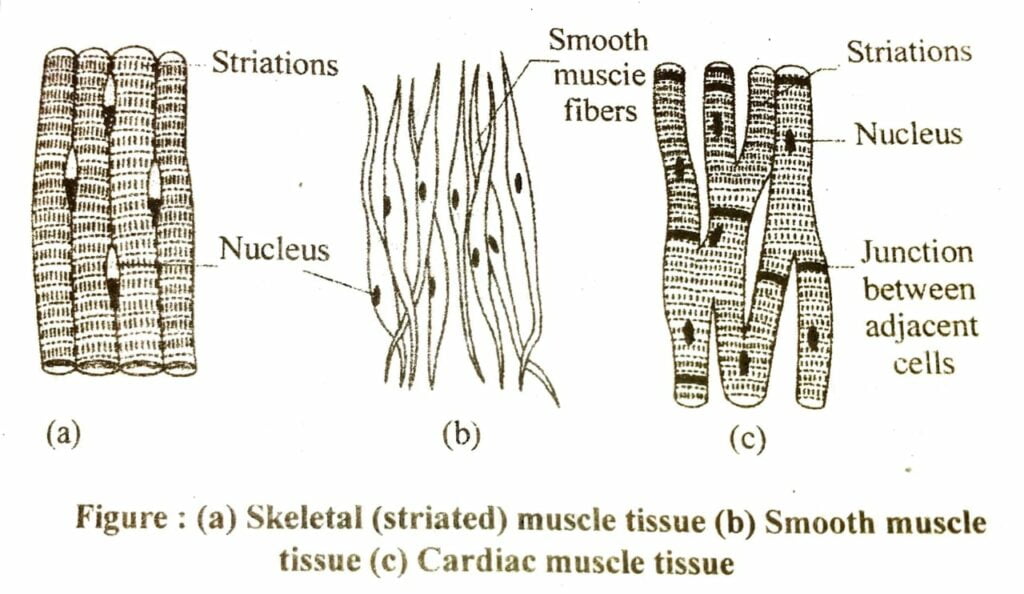
Q.50. Show the structure of the specialised connective tissues present in our body.
Ans :-

Q.51. What are the different types of glandular epithelium and give eg.
Ans :- 2 types of glandular epithelium are -unicellular consisting of isolated glandular cells eg global cells of the alimentary canal and Multicellular, consisting of clusters of cells eg.-Salivary glands.
Q.52. Distinguish between exocrine and endocrine glands.
Ans :- i) Exocrine glands possess duct. They release their secretion through ducts or tubes but endocrine gland do not possess duct so they release their secretion into the fluid bathing the gland.
ii. Section of endocrine glands include mucus, saliva, ear, wak, oil, milk, digestive enzyme but the secretion of endocrine glands are called hormones.
Q.53. Write the function of the cell junction.
Ans :- i) Tight junction- help to stop substances from leaking across a tissue.
ii) Adhering junction- perform cementing to keep neighbouring cells together.
iii) Gap junctions-facilitates the cells to communicates with each other by connecting the cytoplasm of adjoining cells for rapid transfer ions etc.
Q.54. Name the types of Nephridia present in earthworm and also mention this location 3 types of Nephridia are found in earthworm-
Ans :- i) Septal Nephridia-present on both sides of intersegmental septa of segment 15th to the last that open in to intestine.
ii) Intersegmental nephridia- attached to lining of the body wall of segment 3 to the last that open on the body surface.
iii) Pharyngeal nephridia- Present as three paired tufts in the 4th, 5th and 6th segments.
Q.55. Explain the nervous system of earthworm.
Ans :- Nervous system is represented by ganglia arranged segment wise on the ventral paired nerve cord. The nerve cord in the anterior region (3rd + 4th respert) bifurcates, laterally encircling the pharynx and joins the cerebral ganglia dorsally to form nerve ring. The cerebral ganglia along with other nerves is the ring integrate sensory input as well as common muscular responses of the body.
Q.56. Name the organism where calciferous gland is present ? Where it is present ? What is its function.
Ans :- In Earth worm. It is present in the stomach.
The food of earth worm is decaying leaves and organic matter mixed with soil calciferous gland help in neutralising the humic acid present in humus.
Q.57. Describe the reproductive system in Earthworm.
Ans :- Earthworm is hermaphrodite. There are two pairs of testes present in the 10th and 11th segment. Their vasa deferentia run up to the 18th segment where they join the prostatic duct two pairs of accessory glands are present, one pair each in 17th and 19the segments. The common prostate and spermatic duct opens to the exterior by a pair of male genital 4 pair of spermathecae are located in 6th-9th segments one pair of ovaries in present at the inter segmental septum of the 12th and 13th segments. Ovarian funnels are present beneath the ovaries which continue into the oviduct, join together and open on the ventral side as a single media female genital pore on the 14th segment.
Q.58. Draw the alimentary canal of cockroach and write the function of Malpighian tubules.
Ans :-
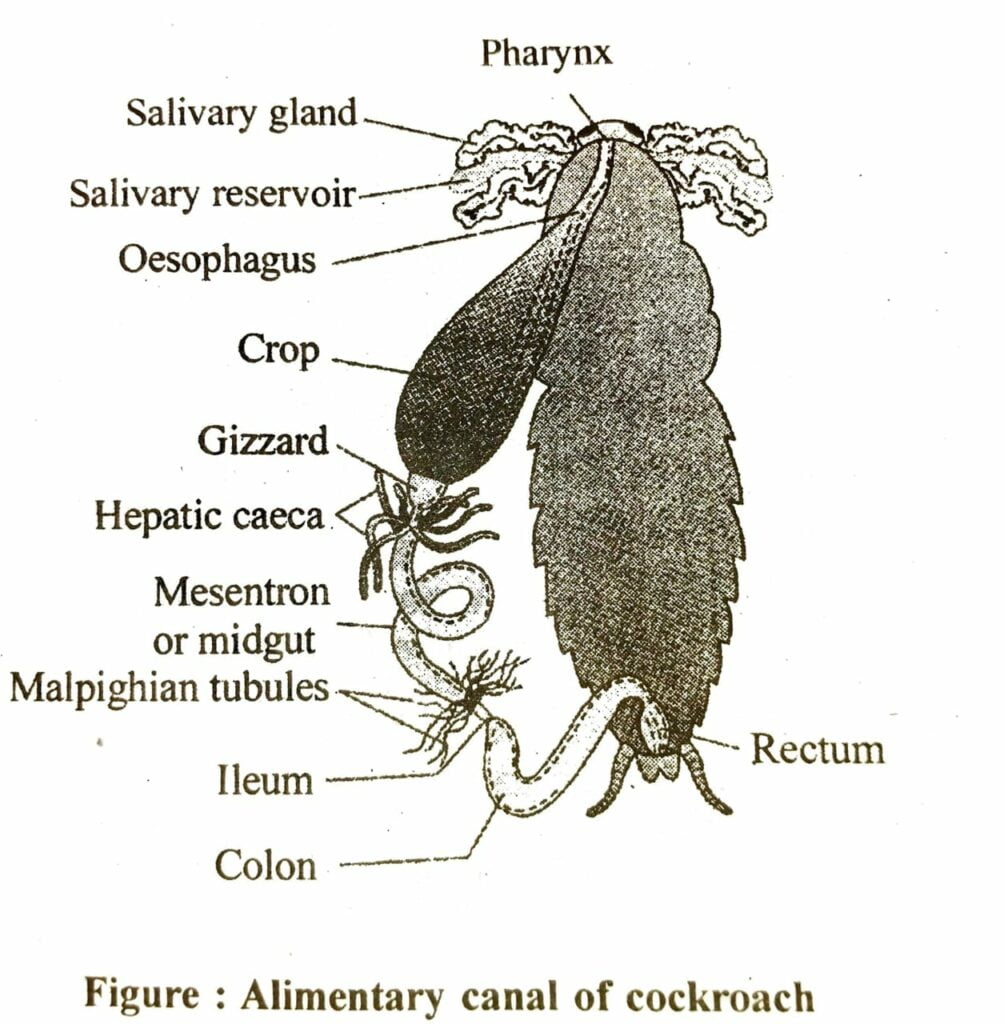
Malpighian tubules-help in removal excretory product from hemolymph.
LONG ANSWER TYPE QUESTIONS
Q.59. Explain the female reproductive system of cockroach (with diagram).
Ans :- Female reproductive system consist of a pair of ovaries, lying laterally in he 2nd – 6th abdominal segment. Earth ovary is formed of a group of 8 ovarian, containing a chain of developing ova. The ovary continues down as short muscular tube called oviduct. The right and the left oviduct unite in to a medium oviduct that leads to vagina. Vagina open to the exterior in the 8the Stersum. A pair of spermatheca is present in the 6N segment.
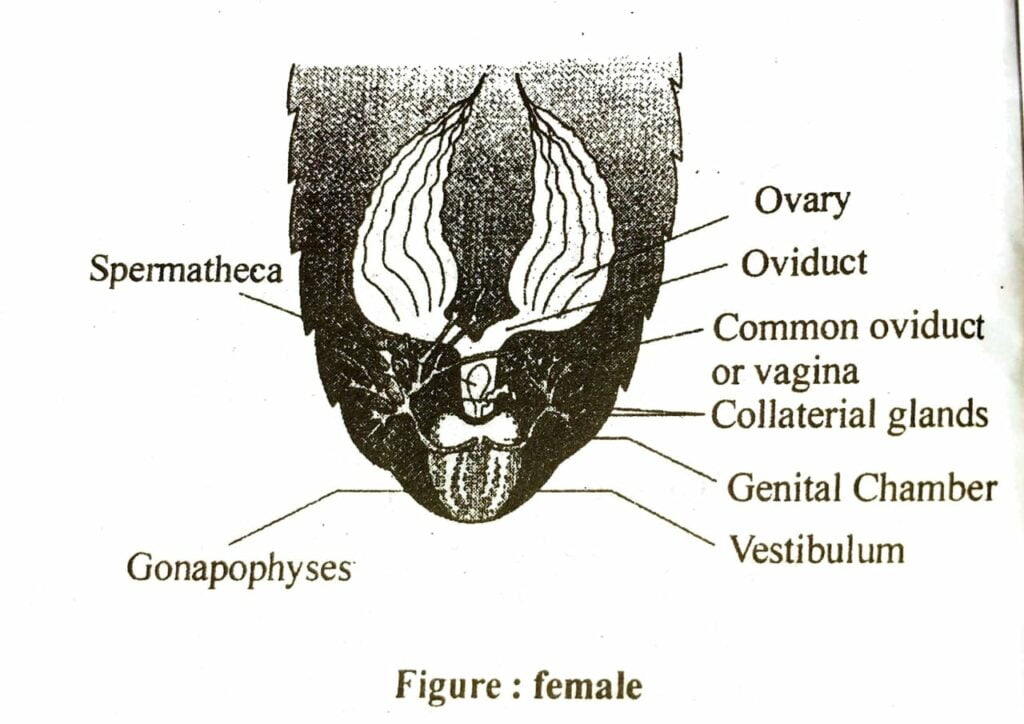
Q.60. Explain the male reproductive system of cockroach (with diagram).
Ans :- Male reproductive system consist of a pair of testes in the 4wg-6w abdominal segment from each testes arisesa the vas deferens, which opens into the ejaculatory duct through seminal vesicle. The ejaculatory duct opens into male gonopore. A characteristic mushroom shaped gland is present in the 6th-7th abdominal segments which function as an accessory reproductive gland. The external genitalia are represented by male gonapophysis.
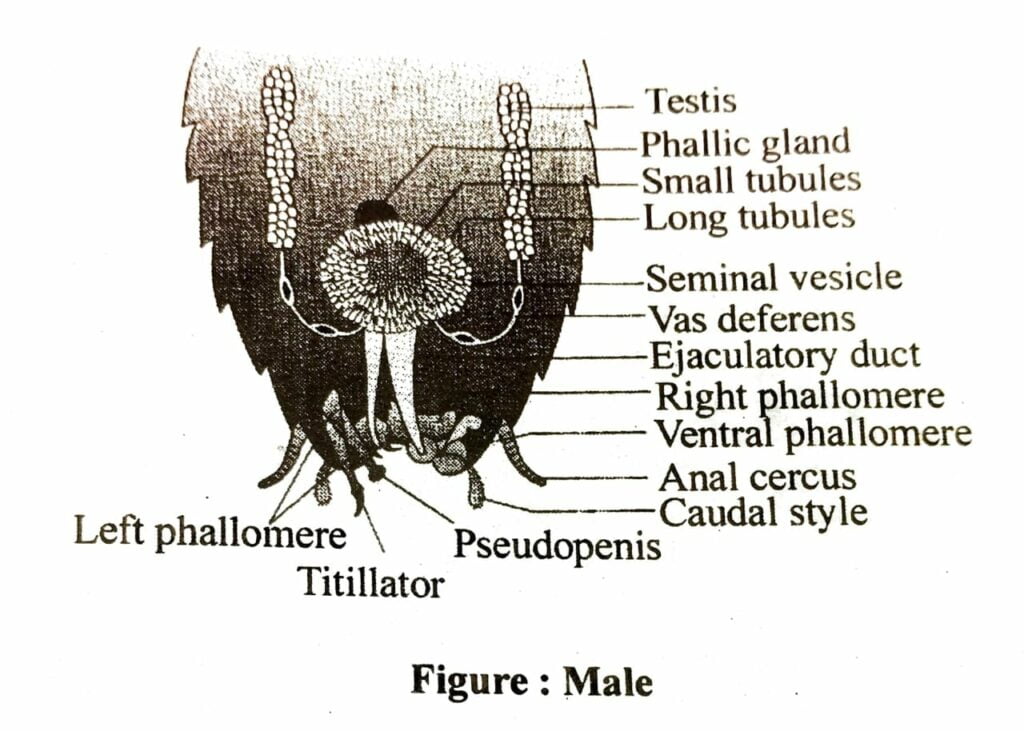
Q.61. Explain the digestive system of frog.
Ans :- The digestive system consist of alimentary canal and digestive glands. The mouth opens into the buccal cavity that leads to oesophagus through pharynx. Oesophagus is short and open into the stomach which in turn continues as the intestine, rectum and finally opens outside by the cloaca. Liver se Liver secretes bile that is stored in the gall bladder. Pancreas in digestive gland produces pancreatic juice containing digestive enzymes. Food is captured by bilobed tongue. Digestion of food takes place by the action of He and gastric juice secreted from the walls of the stomach. Then the partially digested food is passed from stomach to the duodenum where the chyme come in contact with biletuice and pancreatic juice. Bile emulsifies fat and pancreatic juices digest carbohydrates and proteins. Final digestion take place in the intestine. Digested food is absorbed by villi and microvilli and the undigested food moves in to the rectum and passes out through cloaca.
Q.62. Draw the digestive system of frog and write the function.
(a) Bill
(b) Villi
(c) Pancreas
Ans :-
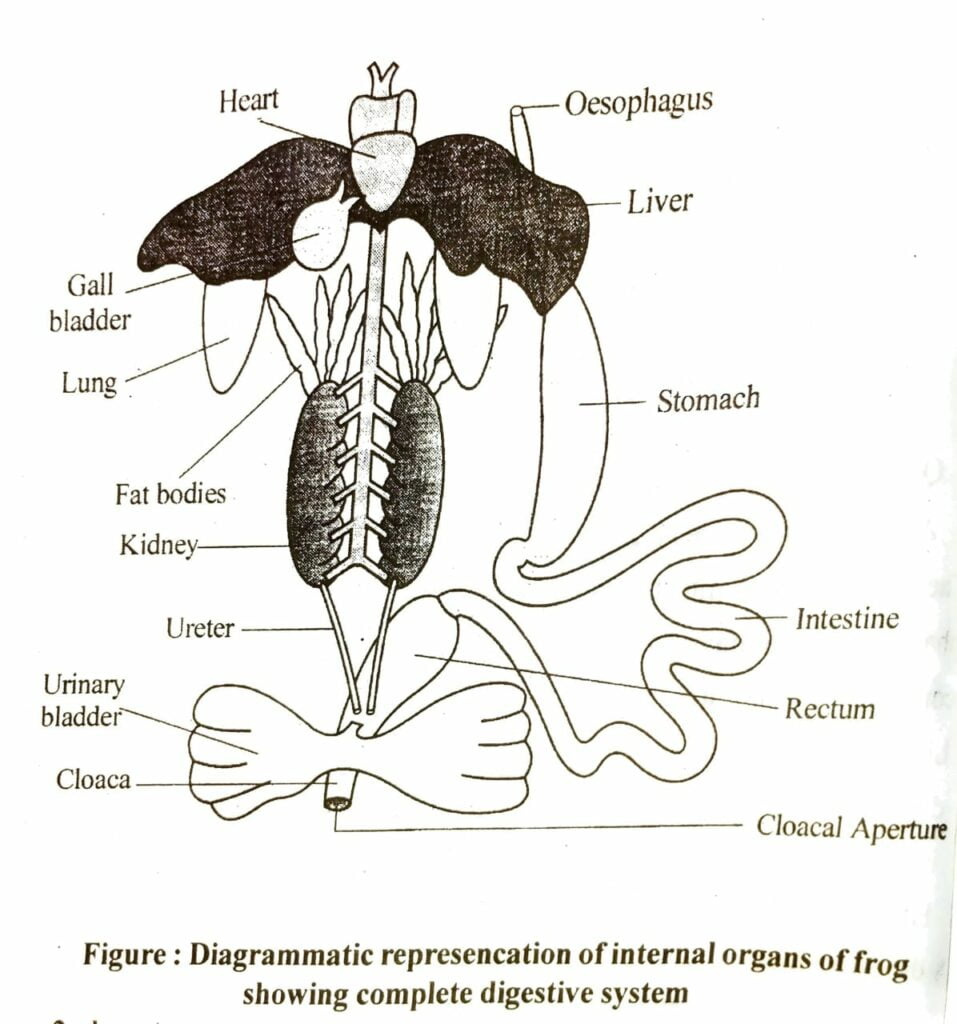
2nd part
Bile – Emulsifies the fat particles.
Villi – Help in absorbing food particles.
Pancreas – Rich in digestive enzymes.
Q.63. (i) With the help of diagram show the Male reproductive system of frog.
(ii) What is cloaca ?
(iii) Write the function of Vasa efferentia.
Ans :-
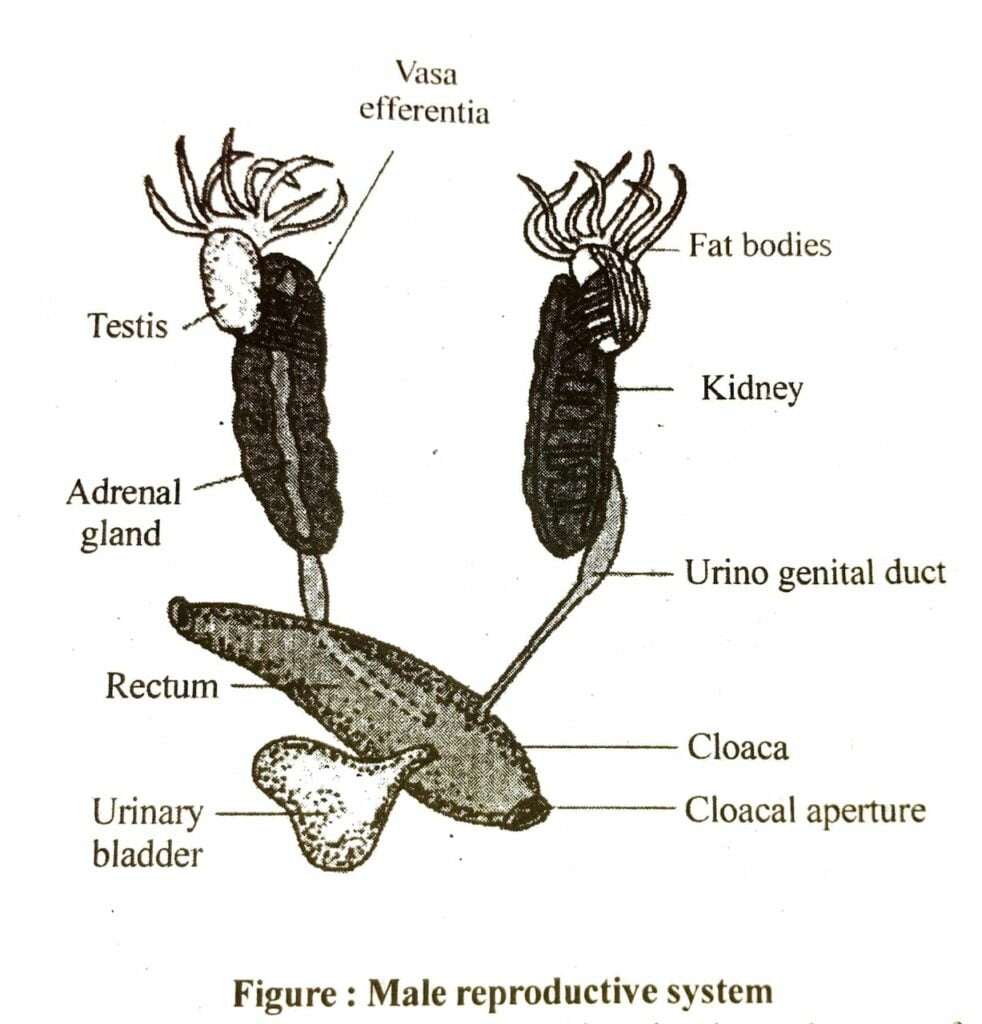
(ii) The cloaca is a small median chamber that is used to pass fecal matter, urine and sperms to the exterior.
(iii) It consist of a pair of ovaries near the kidneys. A pair of oviducts arises from the ovaries and opens into the cloaca separately.

Hi, I’m Dev Kirtonia, Founder & CEO of Dev Library. A website that provides all SCERT, NCERT 3 to 12, and BA, B.com, B.Sc, and Computer Science with Post Graduate Notes & Suggestions, Novel, eBooks, Biography, Quotes, Study Materials, and more.


